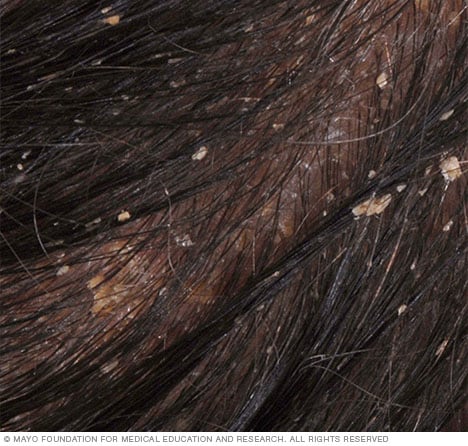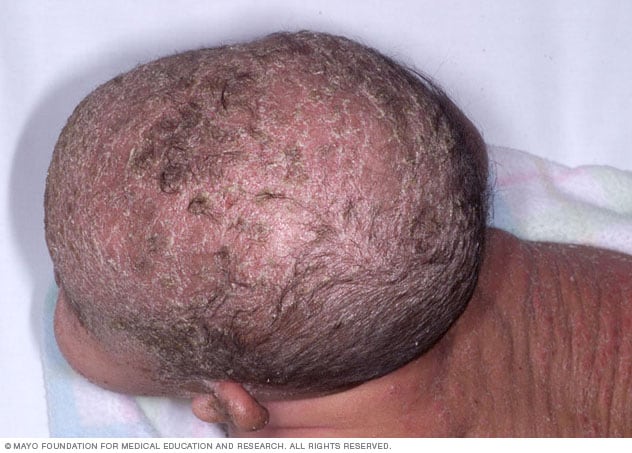Seborrheic dermatitis
Seborrheic dermatitis
overview
Seborrheic dermatitis on the face

Seborrheic dermatitis on the face
Seborrheic dermatitis causes a rash with yellowish and somewhat “oily” scales. In addition to the scalp, seborrheic dermatitis can occur on the sides of the nose, in and between the eyebrows, and other oil-rich areas.
Seborrheic (seb-o-REE-ik) dermatitis is a common skin condition that primarily affects your scalp. It causes flaky patches, red skin and stubborn dandruff. Seborrheic dermatitis can also affect oily areas of the body such as the face, nostrils, eyebrows, ears, eyelids and chest.
Seborrheic dermatitis can go away without treatment. Or you may need many repeated treatments before symptoms disappear. And they can return later. Cleansing daily with a gentle soap and shampoo can help reduce oiliness and the buildup of dead skin.
Seborrheic dermatitis is also called dandruff, seborrheic eczema and seborrheic psoriasis. In infants, the condition is known as cradle cap and causes crusty, scaly patches on the scalp.
Symptoms
Seborrheic dermatitis of the scalp

Seborrheic dermatitis of the scalp
Seborrheic dermatitis is a skin condition that primarily affects the scalp, causing itchy, yellow or white, patchy scales or thick crusts that can attach to the hair shaft, as seen on the bottom left of the image.
Cradle cap on fair skin

Cradle cap on fair skin
Cradle cap is characterized by scaly patches on a baby's scalp. You may notice thick, yellow patches of skin. The spots may be crusty or greasy.
Cradle cap on dark skin

Cradle cap on dark skin
Cradle cap appears as patchy scales or thick crusts on the scalp and oily skin covered with flaky white or yellow scales. Cradle cap usually does not bother the infant.
Signs and symptoms of seborrheic dermatitis may include:
- Hautschuppen (Schuppen) auf Kopfhaut, Haaren, Augenbrauen, Bart oder Schnurrbart
- Flecken fettiger Haut, bedeckt mit schuppigen weißen oder gelben Schuppen oder Krusten auf Kopfhaut, Gesicht, Nasenflügeln, Augenbrauen, Ohren, Augenlidern, Brust, Achselhöhlen, Leistengegend oder unter den Brüsten
- Rote Haut
- Juckreiz
The signs and symptoms can be more severe when you are stressed, and they tend to flare up during cold, dry seasons.
When to go to the doctor?
See your doctor if:
- Sie fühlen sich so unwohl, dass Sie den Schlaf verlieren oder von Ihren täglichen Routinen abgelenkt werden
- Ihr Zustand verursacht Verlegenheit und Angst
- Sie vermuten, dass Ihre Haut infiziert ist
- Sie haben erfolglos versucht, sich selbst zu pflegen
Causes
Doctors do not yet know the exact cause of seborrheic dermatitis. It may be related to:
- Eine Hefe (Pilz) namens Malassezia, die sich in der Ölsekretion auf der Haut befindet
- Eine unregelmäßige Reaktion des Immunsystems
Risk factors
A number of factors increase the risk of developing seborrheic dermatitis, including:
- Neurologische und psychiatrische Erkrankungen wie Parkinson und Depressionen
- Ein geschwächtes Immunsystem, wie es bei Empfängern von Organtransplantationen und Menschen mit HIV/AIDS, alkoholischer Pankreatitis und einigen Krebsarten beobachtet wird
- Erholung von belastenden Erkrankungen wie einem Herzinfarkt
- Einige Medikamente
Sources:
- Gibson LE (Gutachten). Mayo Clinic, Rochester, Minnesota, 6. April 2017.
- Clark GW, et al. Diagnose und Behandlung von seborrhoischer Dermatitis. Amerikanischer Hausarzt. 2015;91:185.
- Pizzorno JE, et al. Seborrhoische Dermatitis. In: Lehrbuch der Naturheilkunde. 4. Aufl. St. Louis, Mo.: Churchill Livingstone Elsevier; 2013. https://www.clinicalkey.com. Abgerufen am 3. April 2017.
- Sasseville D. Seborrhoische Dermatitis bei Jugendlichen und Erwachsenen. https://www.uptodate.com/home. Abgerufen am 3. April 2017.
- Schuppen: Wie behandeln. Amerikanische Akademie für Dermatologie. https://www.aad.org/public/diseases/hair-and-scalp-problems/dandruff-how-to-treat. Abgerufen am 3. April 2017.
- Ramos-e-Silva M, et al. Red face revisited: Endogene Dermatitis in Form von atopischer Dermatitis und seborrhoischer Dermatitis. Kliniken für Dermatologie. 2014;32:109.
- Dessinioti C, et al. Seborrhoische Dermatitis: Ätiologie, Risikofaktoren und Behandlungen: Fakten und Kontroversen. Kliniken für Dermatologie. 2013;31:343.
- Fragen Sie MayoExpert. Seborrhoische Dermatitis. Rochester, Minnesota: Mayo Foundation for Medical Education and Research; 2016.
- Gesundheitsratgeber: Elidel (Pimecrolimus)-Creme und Protopic (Tacrolimus)-Creme. US Food and Drug Administration. https://www.fda.gov/Drugs/DrugSafety/PostmarketDrugSafetyInformationforPatientsandProviders/ucm153941.htm. Abgerufen am 3. April 2017.
- Okokon EO, et al. Topische Antimykotika bei seborrhoischer Dermatitis. Cochrane-Datenbank systematischer Reviews. http://onlinelibrary.wiley.com/doi/10.1002/14651858.CD008138.pub3/full. Abgerufen am 3. April 2017.
- Ferri FF. Seborrhoische Dermatitis. In: Ferri’s Clinical Advisor 2017. Philadelphia, Pa.: Elsevier; 2017. https://www.clinicalkey.com. Abgerufen am 4. April 2017.
- Papadakis MA, et al., Hrsg. Dermatologische Erkrankungen. In: Current Medical Diagnosis & Treatment 2017. 56. Aufl. New York, NY: McGraw-Hill-Bildung; 2017. http://accessmedicine.mhmedical.com. Abgerufen am 4. April 2017.
- Goldsmith LA, et al., Hrsg. Seborrhoische Dermatitis. In: Fitzpatricks Dermatologie in der Allgemeinmedizin. 8. Aufl. New York, NY: Die McGraw-Hill-Unternehmen; 2012. http://www.accessmedicine.com. Abgerufen am 4. April 2017.

 Suche
Suche
 Mein Konto
Mein Konto